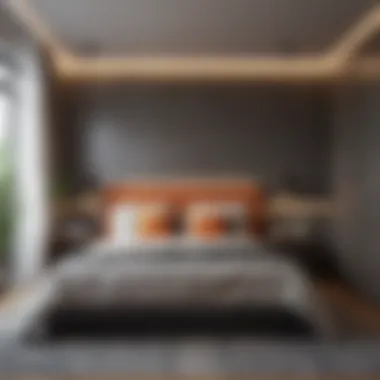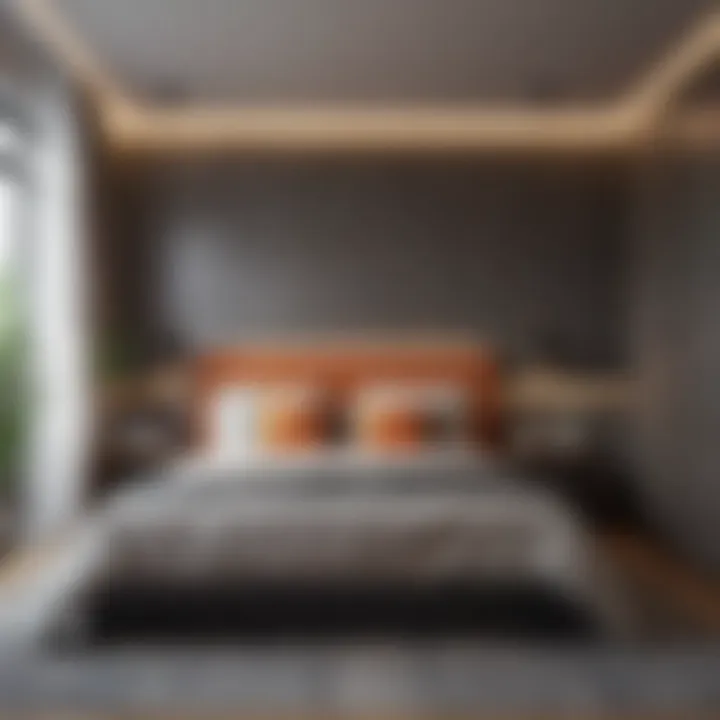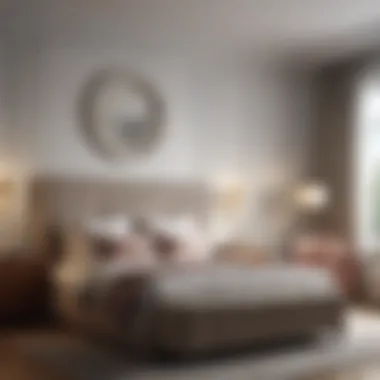Maximizing Space: Smart Organization for Small Bedrooms


Intro
Small bedrooms can often feel more like cozy nooks than personal retreats, making organization a key player in optimizing these spaces. If you find yourself in a constant battle with clutter, it's time to rethink your approach. This guide is not just about squeezing an extra drawer into a tight corner or fitting the biggest bed possible into your room. Rather, it explores how to thoughtfully design your personal space, catering to both functionality and aesthetics.
By diving into the world of compact living, where neatness and order rule, we can transform our small bedrooms into havens of comfort and style. The secret lies in understanding that effective organization goes beyond mere storage solutions; it’s about creating an environment that resonates with your personality while maximizing every inch of available space.
There is a plethora of ideas waiting to spark your creativity, from trending styles that redefine the concept of minimalism to color palettes that can brighten your small haven. By the end of this guide, not only will you have actionable advice on how to manage space effectively, but also insights into products that can seamlessly complement your design vision.
Design Inspirations
When it comes to designing a small bedroom, inspiration is everywhere. Finding the right style can set the tone and influence how you organize your belongings.
Trending Styles
Modern minimalism is a popular choice among those looking to balance function with flair. The essence of minimalism is to embrace simplicity and utility, allowing each piece to shine without feeling cluttered. Think clean lines and open spaces.
On the other hand, vintage charm can also be a winning strategy. Not only does it bring character, but incorporating antique or retro pieces can often provide unique storage solutions. Often, these pieces are designed with hidden compartments or utilize unconventional shapes, perfect for small spaces.
Color Palettes
The choice of color can greatly affect the perception of space. Light colors, particularly whites, soft greys, and pastels, can create the illusion of a room that feels larger. These hues can reflect light and brighten up corners that would otherwise feel dark. To add depth, consider incorporating a bold accent wall or colorful decor elements.
A good mix between light and dark can offer balance, though too much contrast in a small room may overwhelm. Using different shades of the same color can bring sophistication and keep the eye flowing throughout the space.
Product Recommendations
When it comes to small bedroom organization, the right products can make all the difference. Selecting functional yet stylish products is key.
Bedroom Essentials
- Space-Saving Beds: Look for options like murphy beds or loft beds. They are not just practical but can also create additional floor space for activities.
- Multi-functional Furniture: Consider a bench that has storage inside, or an ottoman that doubles as both seating and a place to stash blankets.
- Vertical Storage Solutions: Tall bookshelves or wall-mounted shelves can utilize the often-overlooked vertical axis in small rooms.
Bath Accessories
- Over-the-Door Hooks: Perfect for towels or clothes, they save valuable space and reduce clutter.
- Hanging Shelves: Installing shelves above sinks or toilets can provide essential storage without taking floor space.
"In a small room, every inch counts. Be clever with your organization to make the most of your space."
By taking these design inspirations and product recommendations into account, we can pave the way toward mastering the nuances of small bedroom organization. The journey to achieving a chic, personalized, and efficient space isn’t just about saving room; it’s about enhancing your quality of life.
Understanding the Challenges of Small Spaces
Understanding the challenges inherent to small spaces is key when it comes to maximizing the functionality and aesthetic of a small bedroom. The realities of confined quarters pose distinct hurdles that, if overlooked, can lead to frustration and chaos. In a small bedroom, every square foot counts; therefore, acknowledging these challenges allows for thoughtful solutions that enhance both livability and style.
When dealing with a small bedroom, it’s crucial to recognize that limited space often results in specific issues that need tackling. Being aware of these problems lays a solid foundation for developing effective organization strategies. Moreover, mastering the nuances of space usage can significantly transform a cramped area into a serene sanctuary where comfort reigns supreme.
Identifying Common Issues
Limited storage options
Limited storage options stand out as a primary concern. Unlike larger spaces, small bedrooms often lack the luxury of ample closet or cabinet space. Consequently, residents frequently find themselves grappling with where to store their belongings. This limitation can lead to a messy environment if not handled correctly. Clever use of furniture that doubles as storage can alleviate this issue, allowing homeowners to optimize every available inch. The unique aspect of limited storage is its direct relationship with everyday life, impacting not just aesthetics but functionality as well. The key takeaway here is that acknowledging this limitation can inspire creative solutions that increase both organization and comfort.
Clutter accumulation
Another critical issue for small bedrooms is clutter accumulation. Without sufficient storage solutions, items can pile up quickly, turning what should be a restful room into a source of stress. The fact is, clutter can cloud your mind and diminish your overall quality of sleep. Recognizing how easily clutter sneaks in is essential for implementing preventive measures. By establishing regular decluttering rituals and being mindful of what comes into the room, homeowners can maintain a harmonious atmosphere. The challenge here is about consistency; it requires ongoing commitment but pays dividends in overall well-being.
Misuse of vertical space
Misuse of vertical space represents a common oversight in small bedrooms. People often forget that the walls can serve as valuable areas for storage and decor. Utilizing wall space effectively can give the illusion of additional room. From wall-mounted shelving to hooks and pegboards, there’s a wealth of possibilities that can elevate decor while keeping items organized. This approach also helps to create a more open feel, which is vital in small spaces. The key characteristic of this issue lies in understanding that vertical space isn't just for decoration — it’s a practical consideration that can drastically change the room's dynamics.
The Impact of Layout
Flow and accessibility
When it comes to a small bedroom, flow and accessibility significantly shape the overall experience. An effective layout allows for ease of movement, ensuring that every part of the room is reachable without a fuss. Poor layout can lead to a sense of confinement and irritation. It’s essential to arrange furniture in a way that channels movement smoothly through the space. The uniqueness of this aspect lies in its psychological influence — how the room feels is just as important as how it looks.
Furniture placement
Furniture placement plays a pivotal role in optimizing a small bedroom's layout. Merely jamming furniture into the area without consideration can lead to a cramped feeling. Proper placement can enhance functionality considerably. A well-thought-out arrangement helps delineate areas for various activities, making daily routines flow more seamlessly. The challenge here is striking a balance between aesthetics and practicality; a room can look stylish while still serving its primary purposes.
Creating zones within the space
Creating zones within the space can be both an art and a science. Delineating specific areas for sleeping, working, or relaxing can make a small bedroom feel much larger and more usable. This thoughtful zoning helps in organizing activities, keeping clutter related to each zone contained. The advantage of implementing zones is that it allows for a personalized experience within the confines of a small area. By distinguishing spaces, one can create tailored environments that cater to various needs, making the bedroom a multi-functional retreat.
Furniture Selection for Compact Spaces
Selecting the right furniture is crucial when navigating the challenges of a small bedroom. The right pieces can enhance your space significantly, creating a balance between functionality and style. This section emphasizes how various furniture types can optimize both storage and comfort, making your compact bedroom not just livable but enjoyable.
Choosing Multi-Functional Furniture
Murphy beds
Murphy beds, also known as wall beds, have revolutionized small space living. These ingenious pieces fold up against the wall when not in use, freeing up floor space for other activities. The key characteristic that sets Murphy beds apart is their ability to convert a bedroom into a multi-purpose space without sacrificing comfort. It's no wonder they are a sought-after solution for many looking to master organization in tight quarters.
The unique feature of these beds is their ease of use; you can have a cozy bed ready to go within seconds. However, on the downside, their installation can sometimes require professional help, which may be a consideration for those preferring DIY projects.
Storage ottomans
Storage ottomans are another versatile choice that serves dual purposes — seating and storage. They come in various shapes and styles, allowing them to fit into any decor seamlessly. Their main appeal lies in their hidden compartment, perfect for stashing away books, blankets, or other items that would otherwise clutter the space.


A standout feature is their mobility; you can easily move them around, making them both functional and decorative. Still, caution is needed when selecting the right size, as some can take up more room than expected, limiting available floor space.
Foldable desks and tables
When it comes to maximizing utility in a small bedroom, foldable desks and tables shine. Ideal for those needing a work or study area, they can be compactly stored away when not in use. The defining feature of foldable furniture is its practical design—offering flexibility without permanently occupying space.
These pieces are especially popular because they allow users to create a functional workspace that disappears when it’s not needed. However, one disadvantage might be that they can sometimes feel less sturdy than traditional furniture, depending on the model and construction.
Opting for Minimalist Designs
Choosing minimalism in furniture not only creates visual space but also promotes a clutter-free environment. This approach can simplify room organization by focusing on essential items that serve multiple purposes.
Streamlined silhouettes
Streamlined silhouettes can lend an open feel to your bedroom, making it appear larger than it is. Their simple lines and unembellished forms allow for easy integration into any decor style. The beauty of these designs lies in their unobtrusive nature, promoting an airy ambiance.
While this style is often praised for its elegance, people need to ensure they don’t compromise personal style for simplicity, as it may sometimes feel too sterile without proper accents.
Neutral color palettes
Neutral color palettes contribute significantly to the perception of space. Shades like beige, gray, and soft white reflect light well, creating an illusion of openness. Additionally, they provide a perfect backdrop for introducing colorful accents through textiles or decor.
The unique advantage of neutral tones is their versatility; they can be updated with ease. However, using only neutrals may sometimes result in a lack of personality, so blending in some textured fabrics can help overcome this.
Transparent materials
Finally, transparent materials, such as acrylic or glass, can enhance the feeling of spaciousness in a small bedroom. Their visibility allows light to flow freely, creating a less cluttered look. This characteristic is particularly beneficial in smaller rooms where every square inch counts.
On the flip side, transparent pieces can showcase clutter rather than hide it, thus necessitating a consistent cleaning regimen to maintain an organized appearance.
In sum, the selection of furniture tailored for compact spaces can make a world of difference in how a small bedroom feels and functions. By focusing on the right characteristics, such as multi-functionality and minimalist designs, homeowners can create a space that is not just livable but a true retreat.
Innovative Storage Solutions
Finding ways to maximize storage in a small bedroom is imperative. Innovative storage solutions can make a cramped space feel remarkably clutter-free and organized. Not only do these techniques enhance functionality, they can also improve the aesthetic of the room. When every inch counts, employing clever systems can turn the ordinary into extraordinary.
Utilizing Vertical Space
Wall-mounted shelves
Wall-mounted shelves are a fantastic way to reclaim floor space. By moving upwards, you free up valuable real estate on the ground. This option also allows for decorative display, turning storage into a visual feature.
One of the standout characteristics of wall-mounted shelves is their customizability. You can choose styles that echo your taste—from rustic wood to sleek metal—creating a look that enhances your decor. They're popular in small bedrooms because they don’t just hide clutter; they show it off in a stylish way.
However, it’s crucial to install them securely. If not done right, they can end up damaging walls, or worse, posing a hazard if they fall. This makes proper installation critical.
Over-the-door organizers
Over-the-door organizers are an underutilized gem for small spaces. They’re perfect for stowing away anything from shoes to toiletries without taking up additional floor space, keeping the room airy. Their key characteristic is versatility; they come in various sizes and styles to fit most doors and needs.
Many people favor these organizers because they offer immediate access to everyday items. However, one downside is that they can add visual clutter if overloaded. Keeping only frequently used items can prevent this.
Hanging racks for accessories
Hanging racks for accessories are essential in small bedrooms, allowing you to display and organize items like jewelry, scarves, or bags neatly. The unique feature of these racks is their capability to free up drawer and shelf space, making it easier to locate your belongings quickly.
They’re popular due to their functional design and often artistic aesthetics, acting as both organization and decor. However, you need to ensure they’re placed within reach; otherwise, you might end up making the space feel less accessible.
Under-Bed Storage Options
Drawers on wheels
Drawers on wheels represent a clever solution for small bedrooms by utilizing the often-overlooked space under the bed. This approach offers the advantage of ease; you can slide out and access your belongings effortlessly. They’re particularly great for seasonal items or extra bedding.
The uniqueness of drawers on wheels lies in their ability to contribute to a tidy environment without cluttering your visible space. On the downside, overstuffing these drawers can lead to awkward maneuverability.
Storage bins
Storage bins allow you to organize a wide array of items while keeping the look neat. They can be labeled for easy identification, which helps anyone find what they need without rummaging. The benefit of using various bin sizes is that they can fit together snugly under the bed, maximizing the available space.
However, plastic bins can show wear over time, so choosing bins of good quality is crucial for longevity and a neater aesthetic.
Shoe organizers
Shoe organizers can be an excellent addition to under-bed storage—especially for the shoe enthusiasts among us. They help keep pairs together and prevent them from getting lodged in awkward corners. The main characteristic of these organizers is their compartmentalization; they keep everything tidy.
While shoe organizers represent an excellent way to safeguard footwear, they might not accommodate larger or bulkier shoes as effectively as other storage options, making wise selection important.
Closet Optimization Techniques
Tiered hangers
Tiered hangers allow you to maximize closet space by stacking clothes vertically. This system is especially beneficial for maximizing the use of hanging rods. The beauty of tiered hangers lies in how they can provide an organized appearance, allowing for visibility and easy access to items.
Moreover, they’re instrumental for small closets, ensuring every piece of clothing is on display. However, like most solutions, their utility depends on how well they're maintained. If too many clothes are crammed onto a tiered hanger, it can cause wrinkles.
Space-saving hangers
Space-saving hangers are a lifesaver in tight spaces, as they condense the space occupied by garments. Their key feature is a slim design that allows you to fit more hangers per rack. Homeowners often appreciate how they increase capacity without requiring additional real estate for clothing pieces.


However, it's important to note that their slender design might not be suitable for heavier clothing, needing careful selection based on fabric weight.
Drawer dividers
Drawer dividers can radically transform how one can utilize drawer space. By creating sections, you can prevent chaos and locate items without digging through a pile. This organization method is particularly helpful for smaller drawers, ensuring every piece has its designated spot.
A major advantage of drawer dividers is that they instantly uplift the aesthetic of a messy drawer. However, they require a bit of maintenance—if one section is overstuffed, the rest may become unkempt.
Innovative storage solutions are not just about optimizing space—they're about enhancing your living experience!
In summary, embracing innovative storage solutions lets you maximize every inch of your small bedroom while maintaining style and functionality. Each choice comes with its own set of advantages and pitfalls, and with a little thought, you can tailor storage options that match your lifestyle.
Creating a Functional Layout
Creating an efficient layout in a small bedroom can sometimes feel like solving a challenging puzzle. It’s all about making the best use of the limited space while ensuring that every corner serves a purpose. The ideal layout can transform not just the appearance of a room, but also its utility. An organized space allows for smoother daily routines, accommodates guests comfortably, and ensures a conducive area for work. Here, we’ll delve deeper into how to assess your needs and design specific zones within the small bedroom.
Assessing Your Needs
Before you can start reshaping your bedroom into a functional haven, it's vital to take a step back and evaluate what you truly need from that space. Understanding daily routines, guest accommodations, and workspace requirements can help you make informed decisions on how to configure your layout.
Daily routines considerations
When it comes to daily routines, considering how you use your bedroom can be transformative for the layout. For instance, those who tend to start their day with yoga or a peaceful meditation will benefit from clear, open spaces that allow for movement. Acknowledging this can lead to a more harmonious environment.
Keep in mind, the key characteristic of focusing on daily routines is creating a space that promotes comfort and efficiency. This approach is beneficial because it ensures that every element in the room serves to enhance your day-to-day activities.
One unique feature of this considered layout is the incorporation of easily accessible items. For example, placing a bedside table close to your bed can provide swift access to necessities, while avoiding clutter from accumulating haphazardly. Advantages include quicker mornings, reduced stress, and a clear visual path you can follow while getting ready.
Guest accommodations
Next, let’s discuss the aspect of guest accommodations. This consideration is critical for those who want their small bedroom to be welcoming for visitors. You can achieve this by making sure there’s enough space for a temporary sleeping solution—like a foldable mattress or a pull-out couch.
A key characteristic here is versatility. By providing a flexible sleeping arrangement, you are ensuring that your space is functional for both your needs and those of your guests. This is a popular choice in small apartments or studios where every square foot has to work harder.
The unique feature is the ability to transform your everyday setup into a guest-ready environment without permanent changes. Sometimes, it means sacrificing some of your personal decor to make room for that foldable mattress. The advantage is the ability to maintain a dynamic space while accommodating friends and family comfortably.
Workspace requirements
In people's increasingly mobile and adaptable lifestyle, accommodating a workspace within a small bedroom is becoming essential. This might mean integrating a small desk or even a wall-mounted table that can be folded away when you aren’t working.
The key characteristic of assessing workspace requirements is functionality. Having a designated area to work encourages focus and productivity, making it a beneficial choice for many. It cultivates an atmosphere that separates work from leisure.
What makes a workspace in a small bedroom unique is that it can be designed to blend seamlessly with the rest of the room. A compact desk that matches your existing furniture can be a stylish yet utilitarian aspect of your layout. The advantage here lies in promoting an organized lifestyle while keeping distractions at bay as much as possible.
Designing Zones for Activities
Once you identify your needs, the next step is to create zones for various activities within the bedroom. This segmentation helps in maintaining order by preventing clutter from mixing with different functions of the room.
Sleeping area
The sleeping area should naturally take the forefront in your small bedroom layout. This is where you're meant to unwind and recharge. The key characteristic of focusing on a sleeping zone is ensuring it’s an oasis of calm amid the rest of the room's functionalities. This aspect is essential because proper rest is critical for mental and physical well-being.
Utilizing neutral colors and soft textiles can enhance the ambience of the sleeping area. The unique feature of a well-designed sleeping area is its ability to foster relaxation. Soft lighting or blackout curtains can aid in creating an optimal sleep environment. The drawback might be that it could limit space if not planned appropriately, but a clever arrangement compensates for that.
Reading nook
Having a reading nook can be a delightful addition to a small bedroom. It's a dedicated spot for indulging in books or simply unwinding. The key characteristic here is comfort, paired with a dash of personality. It's about carving out a cozy retreat, even in a compact setting.
One of the advantages is that it can encourage reading habits, which enrich the mind. A small chair, placed by a window with book storage nearby, can serve as a charming reading nook. However, the unique feature of this zone is its adaptability; it can shift to different activities like a small workspace or a crafting corner. Not planning it right may cause the nook to feel cramped, but the right selection of furniture can keep it airy.
Workstation setup
Finally, integrating a workstation setup can often feel like a challenge, yet it is entirely feasible. This area is designed for productivity, irrespective of how small it may be. The key characteristic of a workstation is that it should remain focused on functionality without becoming overwhelming.
By using wall-mounted desks or compact folding tables, you can maintain a tidy aesthetic, making it a beneficial choice for those needing to work from home or study. The unique feature of such setups is that they free floor space when not in use. The limitation might emerge from the compactness, as comfort could suffer with a larger desk, but strategic design choices can still accommodate active working habits.
The takeaway is that a functional layout not only enhances the organization but can significantly improve the overall feel and operation of your small bedroom. Achieving this means understanding your needs, designing purposeful zones, and striking a balance that makes the space work for you.
Aesthetic Considerations
When it comes to small bedroom organization, aesthetics play a pivotal role in transforming a cramped space into a stylish sanctuary. Beyond merely being visually appealing, aesthetic elements directly contribute to the overall ambiance and emotional well-being of the inhabitant. In small spaces, every choice in decor and design can have a profound impact on perception and functionality. A well-planned approach ensures that while maximizing utility, the room still feels inviting and personal.
Here are some significant elements to consider within this context:
- Color Schemes: The hues chosen can drastically alter the perception of space. Light colors can make a room feel larger, whereas darker shades can create intimacy but may also seem constraining in small quarters.
- Personal Touches: Incorporating personal decorations, from photos to keepsakes, adds warmth and character. These elements can make a small bedroom feel more like a home rather than just a space to sleep.
By harmonizing these aesthetic considerations with organizational strategies, you can create a small bedroom that’s not only functional but also resonates with your personal style.
Color Schemes that Enhance Space
Light and airy tones
Light and airy tones are kitchens and quiet corners alike. They help brighten spaces, making them feel both spacious and comfortable. Using whites, soft pastels, or gentle neutrals can help reflect natural light, which is crucial in a tight nook. This choice mimics the openness of a larger environment, essential for people living in smaller homes, where every inch counts.
Key characteristic: The ability to enhance brightness and give an illusion of more space.
Unique feature: Reflective surfaces in light tones can magnify natural light, further enhancing the spacious feel of a small bedroom.
Advantages: They tend to promote calmness and relaxation.


Disadvantages: They can risk appearing sterile or impersonal if not paired with some contrasting elements.
Accent colors for depth
Accent colors serve as a focal point, adding depth to a room's design. In a small space, these can define sections without the need for physical barriers, allowing a perception of distinct areas while still maintaining openness. A bright cushion or an art piece can provide a burst of individuality. These deep shades help create a contrast that can be striking yet inviting.
Key characteristic: They act as punctuation in the color narrative of your space, making it lively.
Unique feature: Adding depth without overwhelming, as they can delineate zones subtly without the need for bulky furniture.
Advantages: Visually engaging and brings personality.
Disadvantages: If used excessively, they can overwhelm or shrink the perceived size of the room.
Patterns that open up the room
Patterns can be a double-edged sword in small spaces. On one hand, they can provide visual interest, while on the other, they can easily become chaotic. When utilized wisely, simple geometric patterns or soft, flowing designs can lead the eye around the room, enhancing the feeling of space and movement. Patterns should ideally be used in moderation to keep the overall look cohesive and not cluttered.
Key characteristic: Creates dynamism without clutter.
Unique feature: The right patterns can create an illusion of movement, which can make a space feel larger.
Advantages: Engages the senses and can personalize spaces beautifully.
Disadvantages: Overuse or a lack of cohesion can create confusion and visual clutter, negating the benefits.
Incorporating Personal Touches
Artwork and decor
Artwork has the power to convey personality and style. Choosing pieces that reflect your taste can foster a sense of belonging, even in a limited area. Selecting smaller, framed pieces can enhance walls without overwhelming them; this lets your individuality shine while keeping the atmosphere serene.
Key characteristic: Direct connection to personal identity and emotional resonance.
Unique feature: The versatility to change, allowing for seasonal or mood-driven alterations of the space.
Advantages: Curates character and uniqueness in the smaller room.
Disadvantages: May require space to display appropriately without creating clutter.
Textiles that add warmth
Textiles are crucial in softening the look of a bedroom. Cushions, throws, and rugs can introduce texture and warmth, creating inviting nooks perfect for relaxation. They also play a dual role in enhancing comfort while offering practical aspects through function. Simple throw pillows or cozy blankets can be all that is needed to finish off a chic bedroom.
Key characteristic: Adds layers and invites touch.
Unique feature: Textiles can be changed out seasonally offering a refreshing new vibe without significant investment.
Advantages: Adds comfort and style without requiring structural changes.
Disadvantages: Requires regular maintenance to avoid wear and tear, not to mention potential clutter.
Plants for a touch of nature
Incorporating plants can breathe life into any bedroom scenario, no matter how small. They not only purify the air but also bring a sense of tranquility. Choosing smaller plants like succulents or hanging pothos can fit even in the tightest spots, guiding natural elements right into your cozy den. The fresh, green color juxtaposes well against most color schemes, enhancing aesthetics.
Key characteristic: Provides organic beauty and the feel of nature indoors.
Unique feature: Can be used in various ways; whether it's on a shelf, hanging above a bed, or on a window sill.
Advantages: Adds vibrancy and inventiveness with natural beauty.
Disadvantages: Certain plants demand more maintenance than others which could be challenging in a small home.
Maintenance Strategies
Regular Decluttering Practices
Scheduled clean-ups
Scheduled clean-ups refer to designating specific times for tidying up your space, and this practice can become a game-changer. Setting aside a short period, say 10 to 15 minutes daily or a more extensive session weekly, can prevent clutter from piling up. This regularity stops the little messes from turning into major projects, which can feel overwhelming.
The key characteristic of this practice is consistency. It’s easier to manage a few items daily than to confront a mountain of clutter at once. However, this consistency demands commitment. A unique feature of scheduled clean-ups is that they can evolve with the seasons or your personal needs, allowing flexibility that caters to fluctuating lifestyles. The advantage here lies in maintaining a high level of organization with minimal effort.
Quarterly reviews
Quarterly reviews take the concept of scheduled clean-ups a step further. These reviews involve a deep dive into your belongings every three months, allowing you to assess what’s been gathered in your space. The main attraction here is awareness; regularly checking in on your items prevents emotional attachments from building toward things you no longer need or use.
Unique to quarterly reviews is the opportunity it provides for a fresh start. As the seasons change, so too can your belongings. You can identify items that have overstayed their welcome and make more informed decisions about what to keep. However, one downside is the time commitment; without a structured approach, these reviews can quickly become time-consuming.
Donation protocols
Donation protocols help streamline the process of giving away items rather than discarding them. It is a fantastic way to maintain a clutter-free space while also contributing to a good cause. Setting up a system for donations—what to keep, what to donate, and where to take those items—can simplify the process. This method emphasizes intentionality with possessions, helping you reevaluate the worth of items in your life. The unique characteristic of donation protocols is how they foster a sense of community, allowing you to connect with others by sharing what you no longer need. Nonetheless, one must keep in mind that not all items are suitable for donation, and researching donation guidelines is necessary to avoid creating extra work later on.
Effective Cleaning Routines
Creating a checklist
Creating a checklist for your cleaning routines transforms cleaning from a daunting task into a manageable activity. This systematic approach allows you to outline everything that needs to be cleaned or organized, ensuring nothing gets overlooked. With the benefit of accountability, checklists keep you on track and motivate you as you tick off completed tasks. The unique feature of a checklist is the ability to personalize it—tailor it to your preferences and needs. This personalization can enhance the effectiveness of your cleaning routine. However, for some, it can also become a chore in itself if the list grows too long or is not updated.
Using appropriate tools
Using appropriate tools can significantly increase the efficiency of cleaning and organizing efforts. Quality cleaning supplies can turn a lackluster routine into an effective one. For instance, a good vacuum cleaner, eco-friendly sprays, or storage bins can save time, energy, and even become a source of enjoyment during the process.
This approach leans heavily on effectiveness; having the right tools ensures you spend less time cleaning up messes and more time enjoying your organized space. While this might require some initial investment, the long-term gains certainly outweigh the costs, in both efficiency and satisfaction.
Maintaining order between deeper cleans
Maintaining order between deeper cleans emphasizes the ongoing nature of organization. It suggests implementing daily habits to keep clutter at bay, such as making your bed, putting clothes away immediately, or doing a quick tidy-up before bed. The main focus here is sustainability; these small, regular actions create a manageable lifestyle where clutter is less likely to accumulate. What’s unique about this approach is its contribution to building a routine that encompasses not just cleaning but overall lifestyle habits. The challenge lay not in making time but in integrating these habits into the daily rhythm of life, which can be difficult but immensely rewarding in the long run.
"A clutter-free space is not merely about cleanliness but about creating a sanctuary that allows rejuvenation and peace of mind."
By implementing these strategies and understanding their inherent value, anyone can work towards a consistently organized and aesthetically pleasing bedroom, regardless of space constraints.



